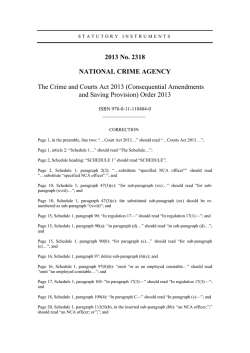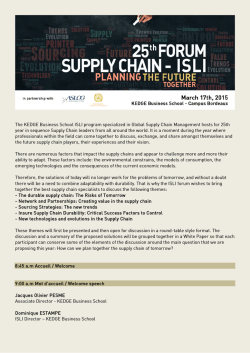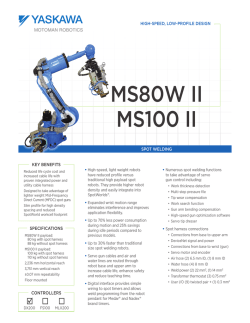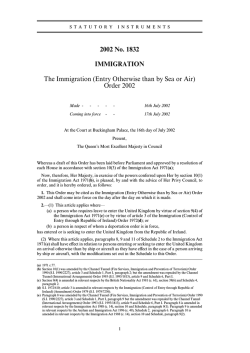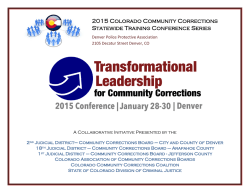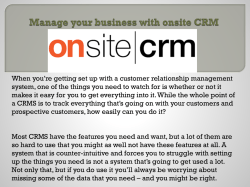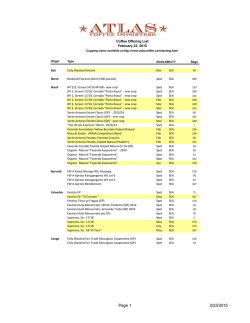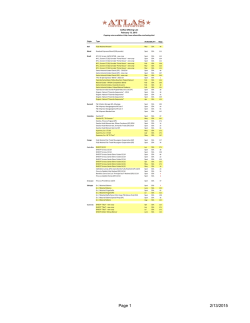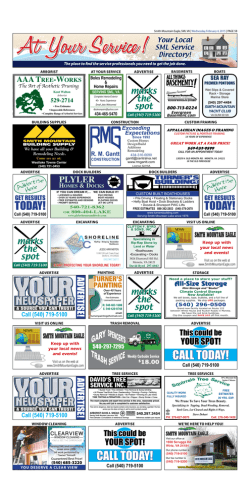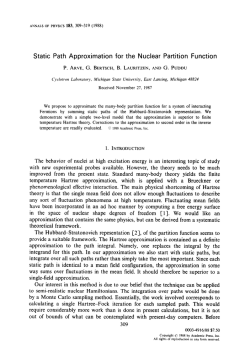
2015 Level II curriculum errata
2015 CFA Program: Level II Errata 28 January 2015 To be fair to all candidates, CFA Institute does not respond directly to individual candidate inquiries. If you have a question concerning CFA Program content, please contact CFA Institute ([email protected]) to have potential errata investigated. The eBook for the 2015 curriculum is formatted for continuous flow, so the text will fit all screen sizes. Therefore, eBook page numbering—which is linked to section heads—does not match page numbering in the print curriculum. Corrections below are in bold and new corrections will be shown in red; page numbers shown are for the print volumes. The short scale method of numeration is used in the CFA Program curriculum. A billion 9 is 10 and a trillion is 1012. This is in contrast to the long scale method where a billion is 1 million squared and a trillion is 1 million cubed. The short scale method of numeration is the prevalent method internationally and in the finance industry. There are a variety ways of quoting foreign exchange rates: $ to or per £ = $/£ = £: $. The quote £:$ is equivalent to a quote of $/£. Authors use the two different methods of quoting currency exchange rates to ensure readers develop familiarity with both. Volume 1 Reading 2: There are a number of corrections in this reading: o In the last line of Example 12 (Using an Expert Network) of Standard II(A), p. 67 of print, “The fund sells its current position in the company and writes buys many put options …” o The Comment on Example 5 (Disclosure of Referral Arrangements and Outside Parties) of Standard VI(C) (page 164 of print) should read “…potential lack of objectivity in the recommendation of Overseas is making by Arrow; this aspect …” Reading 10: In the solution to Practice Problem 2.A (p. 392 of print), the final symbol should be a plus sign instead of equals: Ri = b0 + b1(B/M)i + b2Sizei + i Reading 12: In the second equation of Solution 1 (p. 571 of print), the value for id in the denominator should be 0.0543 (instead of 0.0573). Reading 13: The expanded production function immediately above Section 4.5 (p. 595 of print) should have an equal sign instead of plus. In Example 9, first bullet of Solution to 1 (p. 613 of print), the annual growth rate in population in China was 0.57 instead of 0.97. Volume 2 Reading 17: In the last paragraph of Example 11 (p. 150 of print), make the following edit: “If the fair value of the reporting unit and its net assets were was $800,000 …” Volume 4 Reading 29: There are a number of corrections in this reading: o In the next-to-last paragraph of Section 2.4 (beginning “In this case …” and appearing above Example 1, p. 52 of print), the one-year convergence should be 44.07 percent instead of 42.46 percent. o In the solution to Example 10 (p. 88 of print), WACC is approximately 5.73 percent (instead of 6.13) calculated as WACC = 1.188% + 4.544% = 5.732 percent. o In the solution to Practice Problem 10 (p. 98 of print), the final solution should read 0.043 or 4.3 percent. Reading 33: There are a number of corrections in this reading: o In the fourth bullet point of Example 6 (p. 240 of print), MSEX’s pretax cost of debt is 5.6 percent (instead of 6.9 percent). o In Example 12 (p. 250 of print), the first calculation should show 2.532/80.19 + 0.055 instead of 0.55. The final solution is correct as given. o Question 5 of Example 18 (p. 260 of print) should say that 11 percent growth resumes, instead of 12 percent. Reading 34: There are a number of corrections in this reading: o In the calculation of present values at the bottom of Example 16 (p. 336 of print) the denominator under 54.55 should be to the power 3 instead of 4. The final solution is not affected. o The second paragraph below Exhibit 16 (p. 338 of print) should begin: “After 2017, FCFE will grow …” (instead of 2016). Reading 35: There are a number of corrections in this reading: o In the first paragraph of Example 4 (p. 383 of print), the closing price of TSM was $18.21 (instead of $17.53). o In the paragraph immediately following Example 11 (p. 399 of print), make the following edits to the last sentence: “Given its above-average similar growth and similar lower risk, T should trade at a premium …” o In Example 36 (p. 441 of print), the total market value of the company’s equity should be €5,299.4 million (instead of 5,299.3). The solution should now read: “Enterprise value = €5,299.4 million + €4,522.3 million + €91.5 million – €1,849.9 million = €8,063.3 million. So, EV/S = €8,063.3 million/€10,814.8 million = 0.75.” Reading 37: In the third line of Solution 4.A (p. 590 of print), change intangible assets to fixed assets: “… less the $540,000 required return for working capital and fixed assets).” Volume 5 Reading 38: In the top row of Exhibit 2 of the Practice Problems (p. 68 of print), change NOI for Year 2 to $2,859,119. Reading 42: There are a number of corrections in this reading: o In Solution to 4 of Example 1 (p. 222 of print), the last sentence should read “… threeyear discount factor … divided by the one-year discount factor” (instead of spot rate). o In the second equation of the box “What is Bootstrapping” (p. 228 of print) the numerator of the second term on the right hand side should be 0.0691 instead of 1 + 0.0691. o In the equation following the paragraph “If the trader predicts a flat yield curve of 7%” (bottom of p. 235 of print), the calculation of 9.81% is missing 1 before the equal sign. o In the solution to Practice Problem 5 (p. 272 of print), the market price of the bond will be lower than the intrinsic value (instead of higher). Reading 43: There are a number of revisions in this reading: o The spot rates of 2%, 3.015%, and 4.055% given in the solution to Example 2 are found by bootstrapping, which is introduced in Section 2.1 of Reading 42. Detailed calculations are attached at the end of this Errata listing. o In the Solution to Example 4 (page 293 of print), change eight occurrences of F1,2 to F1,1 in Time 1, and in Time 2 (p. 294 of print) change F2,3 to F2,1. The solutions are correct; only notation changes. Reading 44: In Exhibit 2 of Practice Problems 110 (p. 375 of print), the Year 0 par rate should be 2.2500% (instead of 2.5000). Volume 6 Reading 48: In the formula for valuing a futures contract immediately above Section 7.1.4 (p. 87 of print), the first expression should be vT(T) —i.e., the ‘v’ should be lower case. Reading 49: In the paragraph immediately above Equation 16 (p. 175 of print), the first c should be c+: “We know that H+ = nS+ c+ ...” Reading 53: In the paragraph beginning “Using the two equations …” in Example 13 (p. 429 in print), 2 = 0.06 (equals, instead of minus). Volume 5, Reading 43, Example 2: Calculation of Spot Rates The spot rates may be determined using bootstrapping, which is an iterative process. Using the bond valuation equation below, one can solve iteratively for the spot rates, zt (rate on a zerocoupon bond of maturity t) given the periodic payment , PMT on the relevant benchmark bond. PMT PMT PMT 100 100 ... 1 2 1 z1 1 z2 1 zN N A revised equation, which uses the par rate rather than PMT, may also be used to calculate the spot rates. The revised equation is: Par rate Par rate Par rate 1 1 ... 1 r (1) 1 1 r (2) 2 1 r ( N ) N where par rate is PMT divided by 100 and represents the par rate on the benchmark bond and r(t) is the t-period zero-coupon rate. In this example, the one-year spot rate, r(1) is 2%, which is the same as the one-year par rate. To solve for r(2): 0.03 0.03 1 0.03 0.03 1 1 1 r (1) 1 1 r (2) 2 1 0.02 1 1 r (2) 2 r(2) = 3.015% To solve for r(3): 0.04 0.04 1 1 2 1 0.02 1 0.03015 r(3) = 4.055% 0.04 1 1 r (3) 3
© Copyright 2025
